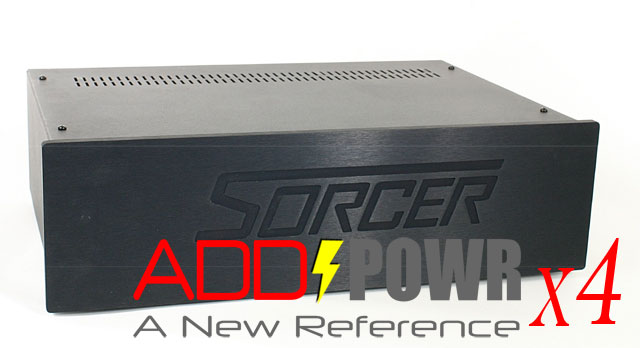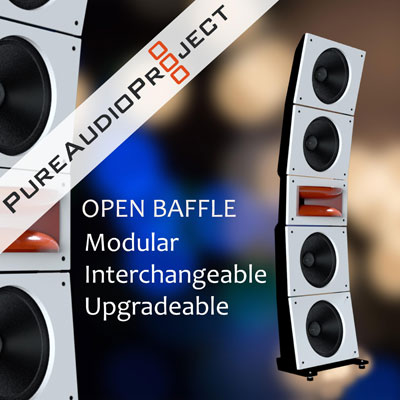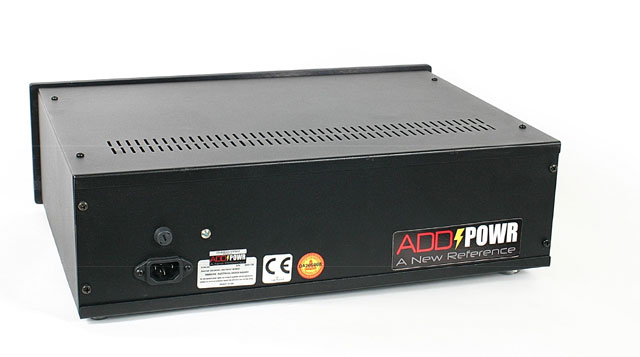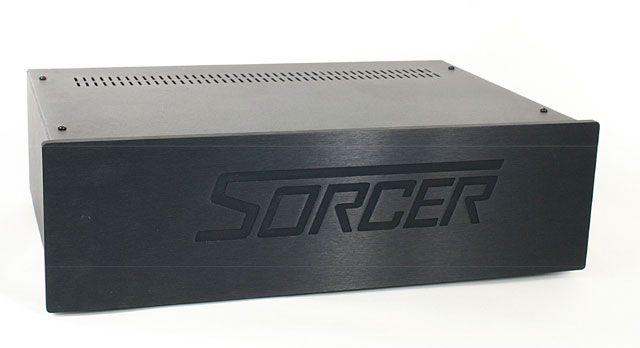ADD-Powr™Sorcer x4 AC conditioner

 Add-Powr products are manufactured in the USA by Coherence Systems. ADD-Powr™ is in the business of creating harmonic resonance for consumer and professional electronics. ADD-Powr™ classifies its products as electrical environment conditioners rather than AC power line conditioners. ADD-Powr’s technology offers three approaches, algorithms, or programs to affect the electrical environment, tuning, and harmonic resonance. The manufacturer notes that the Sorcer x4 Algorithm Digital Defined electrical energy and power component’s design changes the AC line (single-phase) starting from the circuit breaker box and reaching throughout a residence or commercial space. Bill Stierhout, the owner and designer of ADD-Powr line, began in the audio industry in 1999 with two products, the Quantum Symphony and Symphony Pro. I, personally, not knowingly experienced either of these units. Bill reminded me that he had the Sorcer x4 at the last New York Audio Show, where I had briefly hear it.
Add-Powr products are manufactured in the USA by Coherence Systems. ADD-Powr™ is in the business of creating harmonic resonance for consumer and professional electronics. ADD-Powr™ classifies its products as electrical environment conditioners rather than AC power line conditioners. ADD-Powr’s technology offers three approaches, algorithms, or programs to affect the electrical environment, tuning, and harmonic resonance. The manufacturer notes that the Sorcer x4 Algorithm Digital Defined electrical energy and power component’s design changes the AC line (single-phase) starting from the circuit breaker box and reaching throughout a residence or commercial space. Bill Stierhout, the owner and designer of ADD-Powr line, began in the audio industry in 1999 with two products, the Quantum Symphony and Symphony Pro. I, personally, not knowingly experienced either of these units. Bill reminded me that he had the Sorcer x4 at the last New York Audio Show, where I had briefly hear it.
The tech behind these new ADD-Powr’s AC Line Harmonic Resonators is based upon principles of the Fourier series, resonance, and electromagnetic field theory. The Sorcer x4 imparts an algorithmically generated field to eliminate noise in the AC line, improving your AC’s quality, without affecting line impedance and current capacity. The Sorcer series is free of filters, isolation transformers, AC line regeneration, or balanced power technology. ADD-Powr offers numerous products and provides this assessment: “The tonal, dynamic and spatial impacts of the audio experience will vary through the different algorithms each product employs.”
Also from the website, “ADD-Powr components work in any environment but their effectiveness can vary depending on location.” Our space challenges this recommendation, with my rig located on one end of our loft and the breaker panel on the other… I had little choice but to connect the Sorcer x4 near my rig. I can’t really get the Sorcer x4 close to our breaker panel unless I place it on top of our refrigerator, which my wife wouldn’t, uh, appreciate.
The Sorcer x4 “harmonic resonator” uses four AC transformers 110/220 VAC 50/60 Hz, connected in series, and “proprietary digital amplifier circuitry under algorithm control” to re-reference or re-clock the AC line with low-frequency harmonics, which increases the signal to noise ratio. To quote from the website FAQ’s: “Multiple transformers create large electromagnetic fields that can be used to effectively propagate our low-frequency algorithms. They are also an effective low impedance interface to the AC line. The harmonic resonator effect is maximized using several connected in series.”
Speaking With Bill Stierhout
 Once I assembled my review, I sent it along to Bill Stierhout for comment. He called a day later and we had a delightful phone conversation, where we talked about audio and the bobs and weaves of his career in the audio, playing music, and the recording biz. Bill relayed a bit about the technology involved in the unit. “Fourier addresses the nature of complex signals composed of a harmonically related series of sine and cosine waves of various phases.” Rather than try to re-write the following, I’ll quote from the Wikipedia article titled “Resonance” – “Resonance describes the phenomenon of increased amplitude that occurs when the frequency of a periodically applied force (or a Fourier component of it) is equal or close to a natural frequency of the system on which it acts. When an oscillating force is applied at a resonant frequency of a dynamical system, the system will oscillate at a higher amplitude than when the same force is applied at other, non-resonant frequencies.[3]”
Once I assembled my review, I sent it along to Bill Stierhout for comment. He called a day later and we had a delightful phone conversation, where we talked about audio and the bobs and weaves of his career in the audio, playing music, and the recording biz. Bill relayed a bit about the technology involved in the unit. “Fourier addresses the nature of complex signals composed of a harmonically related series of sine and cosine waves of various phases.” Rather than try to re-write the following, I’ll quote from the Wikipedia article titled “Resonance” – “Resonance describes the phenomenon of increased amplitude that occurs when the frequency of a periodically applied force (or a Fourier component of it) is equal or close to a natural frequency of the system on which it acts. When an oscillating force is applied at a resonant frequency of a dynamical system, the system will oscillate at a higher amplitude than when the same force is applied at other, non-resonant frequencies.[3]”
Paraphrasing Stierhout’s explanation of how the X4 works, I add the following: The Sorcer series induces a continuous low frequency pulsed square wave pattern interfaced to the AC line through a Class A amplifier stage. This pulse goes out on the power line to appliances and would typically be filtered out by power supplies, but, because the induced amplifier voltage is so small, only 1/2 v or so, it is not seen by the various power supplies in a residence or commercial space. Being DC, once past power supplies, the pulse enters components, generating a harmonic footprint. To quote Bill, “This “footprint” becomes part of the DC reference. This DC reference is passed onto component power supplies. The altered DC reference contains a Fourier harmonic series based around a low frequency fundamental. The harmonic series of sine waves will resonate with the like frequencies of the program material. The resonance diminishes in intensity as the harmonic series scales upward in the audio spectrum. The diminution occurs rapidly as a logarithmic decay. This means that the energy level of resonance is much less at higher frequencies than at lower frequencies. If this was not the case, then the “musicality” of the effect would be lost. That is a crucial consideration!”
The Sorcer x4’s four transformers radiate a bit and clean up the signal as well. There’s also a board with antennae coils, which generates resonance that travels thru the air. Bill told me that the Sorcer x2, having two fewer transformers, generates less of the intended effect. Like Clement Perry, some people can hear the result and think it’s too much, preferring the less is more approach – hence the placement suggestion away from the audio rig and closer to the breaker panel.
Listening
 I removed the ADD-POWR Sorcer x4 from its thick protective (impressive) case and set it atop the short rack that holds my power amp. Hmm, this is pretty much a black box, I thought. As I glanced at its rear panel, expecting to see receptacles, I was surprised to see just a tiny blue LED bulb, an IEC cable input, and some stickers. A rummage through the case for a power cable came up short, so I brought out a Core Power Technologies Valiant Gold cable to power this stealth unit. When conversing sometime later with Bill Stierhout, the Senior X4’s designer, I found out that this was a demo unit, and its included stock power cable had evidently gone missing.
I removed the ADD-POWR Sorcer x4 from its thick protective (impressive) case and set it atop the short rack that holds my power amp. Hmm, this is pretty much a black box, I thought. As I glanced at its rear panel, expecting to see receptacles, I was surprised to see just a tiny blue LED bulb, an IEC cable input, and some stickers. A rummage through the case for a power cable came up short, so I brought out a Core Power Technologies Valiant Gold cable to power this stealth unit. When conversing sometime later with Bill Stierhout, the Senior X4’s designer, I found out that this was a demo unit, and its included stock power cable had evidently gone missing.
I connected to power and, lacking its own on/off switch, the Sorcer x4 quietly powered on. Once my wife left for a socially-distanced visit with friends, I powered the system for an introductory listen and sat back with the iPad to select some tunes. Béla Fleck and the Flecktones lifts a mood on any given day, so I selected a rip off “UFO TOFU” (Warner Off Roster 1992), an album I’ve been getting to know this disk, with a few partial and full plays over the past month. The first track, Sex In A Pan, always makes me smile, so I pushed play.
Damn! I didn’t expect this… my system came to life – a noticeable shift onward and upward in richness and harmonic detail. But, before I continue with my listening impressions, here’s a bit about this 17.75” x 11.75” deep and 5.25” tall (feet included) 36 lb. unit. Its fit and finish are, in a word, crisp, with ever so snugly assembled planes of horizontal-grained black anodized aluminum. While this demo unit was all black, a silver faceplate can be ordered (chassis will be black) and a plastic top plate is also available, which can help facilitate added output by the antenna coils.
 Doozy 1, from John Taylor’s “2081,” (Cam Jazz 2015), is a minimal piece that always gains my focus, with its piano, tuba, vocal, and drum instrumentation. Without the Sorcer x4 in the mix, it’s always been a sweet, fun piece to relax into on a play day, with its 10:32 minute play day. With the Sorcer x4 engaged, Taylor’s piano gained far more body, heightened harmonics, and depth – and the drums were presented with far more authority and boatloads of dynamics. This, I did not expect… at all.
Doozy 1, from John Taylor’s “2081,” (Cam Jazz 2015), is a minimal piece that always gains my focus, with its piano, tuba, vocal, and drum instrumentation. Without the Sorcer x4 in the mix, it’s always been a sweet, fun piece to relax into on a play day, with its 10:32 minute play day. With the Sorcer x4 engaged, Taylor’s piano gained far more body, heightened harmonics, and depth – and the drums were presented with far more authority and boatloads of dynamics. This, I did not expect… at all.
 I’ll note here that I’m playing from my i7 iMac thru my recently returned-from-firmware upgrade PS Audio Stellar Gain Cell DAC via XLR to the SMS Designs’ S2 Pro stereo amp, and out to the Tekton Double Impacts. I’ve first installed the Sorcer X4 in the same receptacle as my distantly-placed power amp. The Bitter End, from Sinne Eeg’s “Dream” (Stunt 2017) and one that I’ve recently remarked about in a recent review, I noted a greater depth and physicality to the bass, drums, piano… well, everything! The entire stage had considerably more heft and cohesiveness, and Eeg’s voice resonated with more excellent articulation and presence. Moving on to This Thing Called Love, the musicality of instrumentation and voice was enhanced.
I’ll note here that I’m playing from my i7 iMac thru my recently returned-from-firmware upgrade PS Audio Stellar Gain Cell DAC via XLR to the SMS Designs’ S2 Pro stereo amp, and out to the Tekton Double Impacts. I’ve first installed the Sorcer X4 in the same receptacle as my distantly-placed power amp. The Bitter End, from Sinne Eeg’s “Dream” (Stunt 2017) and one that I’ve recently remarked about in a recent review, I noted a greater depth and physicality to the bass, drums, piano… well, everything! The entire stage had considerably more heft and cohesiveness, and Eeg’s voice resonated with more excellent articulation and presence. Moving on to This Thing Called Love, the musicality of instrumentation and voice was enhanced.
Moving on to something decidedly different, and using the iPad and Apple Remote app to access the audio files on my iMac, I selected “67,000 MPH,” from Phronesis’ (EDITION RECORDS LTD.) 2016 release, Parallax and held my breath. This track holds no prisoners, and I wasn’t at all disappointed this time either. Velocity, space, and dynamics flew from the speakers with more urgency and intensity. The piano syncopation and drum dynamics that inhabit the following track, “OK Corale,” were present on a deeper, more joyful stage, again, with more defined imaging. The wonderful riff-raff in “Stillness” made me lean even farther into the proceedings, where even the air between and behind the blackness from which things came, was richer and more resonant.
 Returning to the familiar, I selected Modul 48 from Nik Bärtsch’ Ronin’s Llyria (ECM 2010), a self-made rip from vinyl, early last year. The familiar intersecting and overlapping rhythms and melodic repetition are my jam. In this listen, I’m hearing spittle forming in a mouthpiece, on a dynamic, spirited stage, the music ever-evolving as it weaves around and through the players. Micro transients are better defined and, yet again a piano is delivered with more body, more resolve. The following track Modul 52, springs forward from a deeper stage, and the percussive interplay seems more alive and better textured than in previous listens.
Returning to the familiar, I selected Modul 48 from Nik Bärtsch’ Ronin’s Llyria (ECM 2010), a self-made rip from vinyl, early last year. The familiar intersecting and overlapping rhythms and melodic repetition are my jam. In this listen, I’m hearing spittle forming in a mouthpiece, on a dynamic, spirited stage, the music ever-evolving as it weaves around and through the players. Micro transients are better defined and, yet again a piano is delivered with more body, more resolve. The following track Modul 52, springs forward from a deeper stage, and the percussive interplay seems more alive and better textured than in previous listens.
An accidental touch of the iPad’s Apple Remote app brought up the “1st Movement – Luminous Galaxy” from multi-instrumentalist Terje Rypdal’s Lux Aeterna (ECM 2003). Initially, I scrambled for something else (a rip from CD that I hadn’t listened to in well over a decade… it never caught my attention). Still, the sweetness of this melody, presented with strings that swayed so analog as the notes wafted into our room, well, it captivated me. Rypdal’s trumpet was not over-scaled, nor over insistent in its voice, and melded beautifully with the other instrumentation. The horn was gifted with long decays as this soothing passage unfolded in front of and around me. Roused by its growing ever louder state, the pipe organ broke my concentration and offered more raspy, textural detail and hall nuance. I thought it a studio approximation until I heard a cough and subtle noises from the audience. The bass transitioned the piece to yet more beautiful strings and the twinkling of an orchestra. Rypdal’s distinctive electric guitar entered the space, wiry and searching, the guitar led the melody through this work’s second movement, the air charged with nuance and added harmonics. I had to take a break and compose myself. This CD never enveloped me then, but, through the Sorcer x4, this listen was a fresh and new experience.
A Change In Position
I have both the power amp and Sorcer x4
plugged into our loft’s wall receptacle electric, my system responded beautifully when near the Sorcer x4. With the x4 closer, even our TV’s picture appeared more refined as well. To quote ADD-Powr, “The benefits are unmistakable – greater color saturation/image clarity/dimensionality, greater depth of field, greater contrast, darker black background.” Anything improving video quality makes my wife happy.
I decided to move the Sorcer x4 to my main rack. A separate circuit provides power to all my components, sources, and EQUI=CORE 1800 power conditioner, placing it on the available bottom shelf. The power amp, being farther away, uses a Core Power EQUI=CORE 300.
Once again, a play of both digital and analog sources showed the Sorcer x4 continuing to produce its broader and deeper soundstage, adding air around the instruments, heft to dynamics, and punch to transients and the instruments themselves. More than once, I found myself lowering my normal listening volume down a couple of clicks on the Gain Cell’s remote while listening to Abercrombie, Holland, and DeJohnette’s “Gateway II” (ECM 1977). It played some louder, with more incredible velocity and volume behind the bass and dynamics. DeJohnette’s delicate percussive work seemed farther back on the soundstage, deeper than I recall on its last play in this same rig without the Sorcer x4 installed. I found myself leaning in, picking out the accented detail brought forth by the x4.
The Wrap
I was so taken with the benefit experienced with the ADD-Powr Sorcer x4 in my rig that I rushed to jot down what I was hearing, thereby cutting short the additional weeks (dare I say, months?) of possible listening time I might have had under its spell. With the Sorcer X4 in the mix, everything had a more significant body, a more prosperous presence, and extended depth and width. The ADD-Powr Sorcer x4 is a must-hear, and its manufacturer makes it easy – If you are not satisfied with any Add-Powr product, you can return it within 30 days.


greg voth
Specifications:
ADD-Powr™ Algorithm Digital Defined Power™
Sorcer x4, $3,999.95
Sorcer x2, $2,999.95 (not reviewed)
AC / EMF Conditioner
Completely parallel
Micro-controlled digital amplifier
Four line transformers
Steel chassis w/black anodized aluminum front
Graphene treated wired connections
Weight: 36 lbs.
Dimensions: 17.0” x 11.875” x 4
Electrical: 110/220 VAC 50/60 Hz
Load: < 100mA or 10 watts
External Connections: None
3 rack mount unit (optional)
Contact
310-954-4837
Website: https://add-powr.com
Manufactured in the USA by Coherence Systems
943 Euclid St., Suite A, Santa Monica, CA 90403
Copyright © 2020 ADD-POWR™ – All Rights Reserved.
Stereo Times Masthead
Publisher/Founder
Clement Perry
Editor
Dave Thomas
Senior Editors
Frank Alles, Mike Girardi, John Hoffman, Russell Lichter, Terry London, Moreno Mitchell, Paul Szabady, Bill Wells, Mike Wright, Stephen Yan, and Rob Dockery
Current Contributors
David Abramson, Tim Barrall, Dave Allison, Ron Cook, Lewis Dardick, Dan Secula, Don Shaulis, Greg Simmons, Eric Teh, Greg Voth, Richard Willie, Ed Van Winkle, and Rob Dockery
Music Reviewers:
Carlos Sanchez, John Jonczyk, John Sprung and Russell Lichter
Site Management Clement Perry
Ad Designer: Martin Perry








Be the first to comment on: ADD-Powr™Sorcer x4 AC conditioner